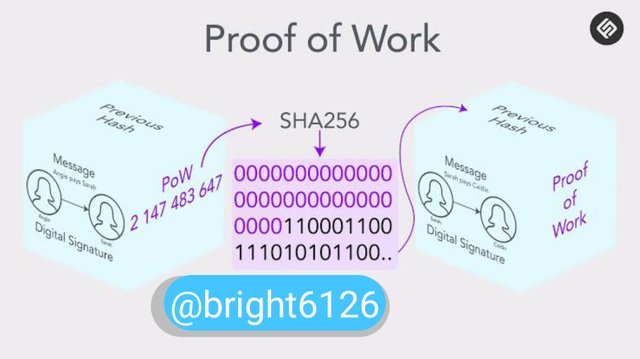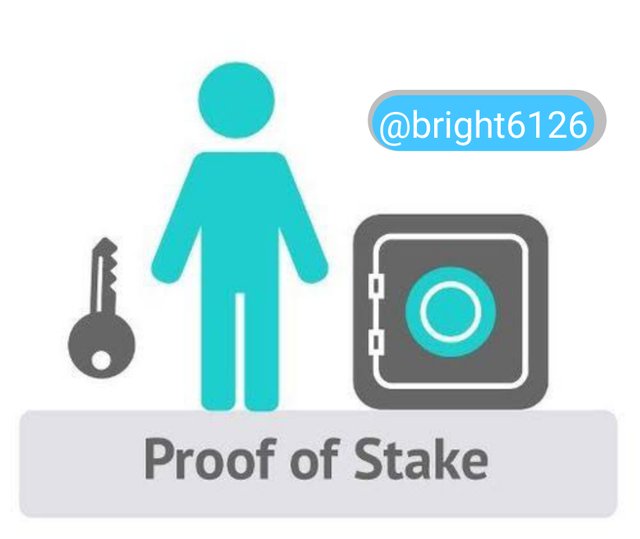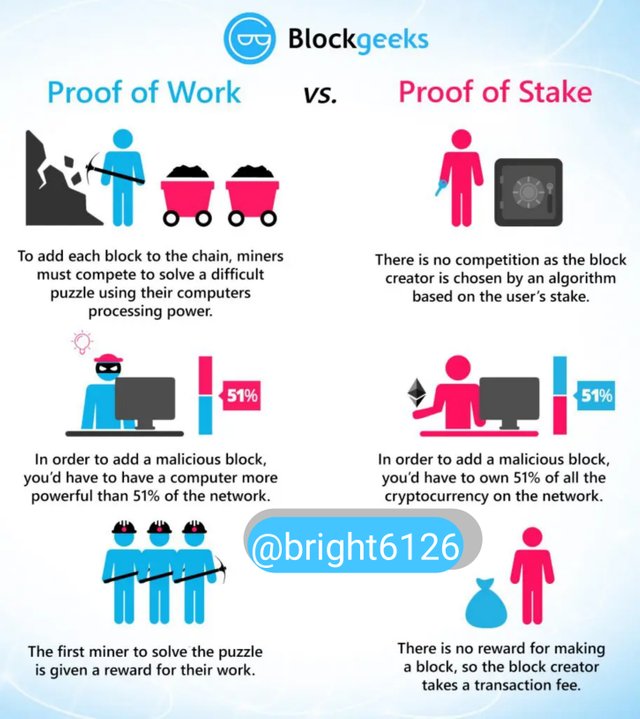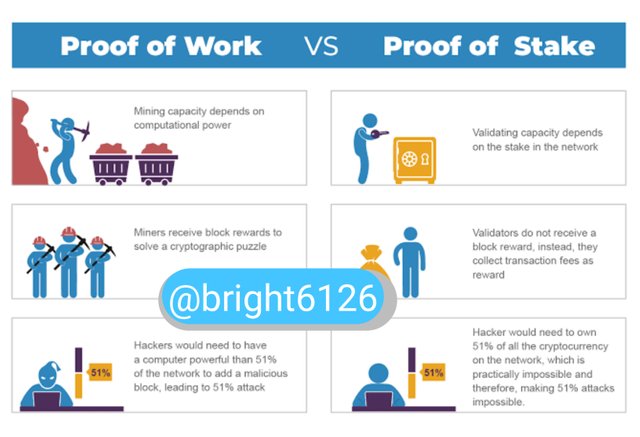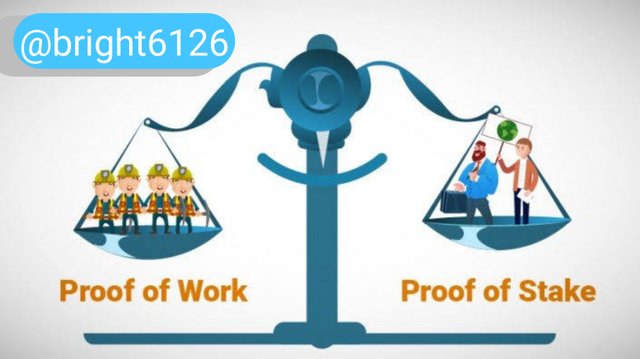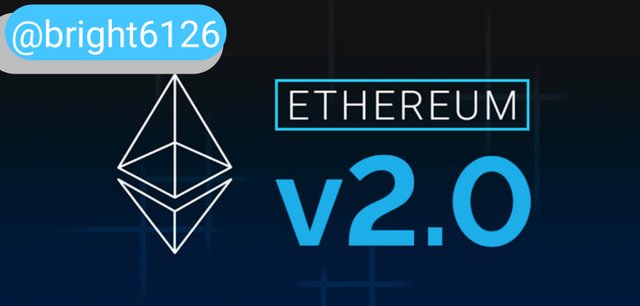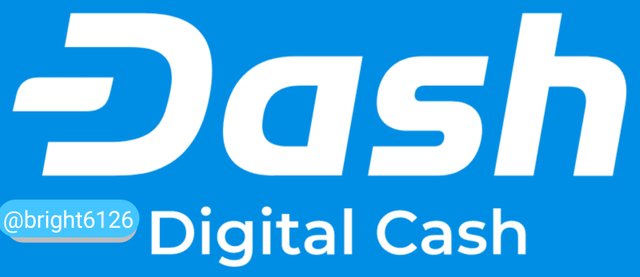Steemit Crypto Academy Season 5 Beginners' Course Homework Post For Task 6 : Title: Different Types Of Consensus Mechanisms Submitted By @bright6126
Special greetings to the steemit social network and compliment of the season. Today I am glad to present my task 6 of the Introductory courses.
- What is the difference between PoW and PoS?
- Advantages and Disadvantages?
- Which one is better in scaling capacity
- Examples?
Before we move forward to differentiate PoW and PoS, it is very imperative that we get the definitions of both terms.
PoW is an acronym for Proof of Work, it simply can be defined as a system which comprises of the main goal of preventing cyber-attacks for example a distributed denial-of-service attack (DDoS) that is capable of finishing the resources of a system by constantly sending series of fake requests.
Proof of work concept has come alive before the advent of bitcoin, but the founder of Bitcoin, Satoshi Nakamoto leveraged optimally this principle to his/her findings (the identity of Nakamoto is unknown till now)
Furthermore, PoW idea was initially released in 1993 by Cynthia Dwork and Moni Naor back in but the word “proof of work” came to live and was coined by Markus Jakobsson and Ari Juels inside a document which was published in 1999.
Meanwhile, currently till date, Proof of Work is probably one of the biggest idea behind the founder of Bitcoin (Nakamoto’s) in his bitcoin white paper that was published back in 2008 – because it allows trustless and distributed consensus.
Proof of Work (PoW) is also a protocol developed explicitly to create digital transactions secure without having to believe in a 3rd party's.
The work that is processed into solving puzzle does generates rewards in favour of whosever sort it out and is referred to as mining. Thus, this can be an algorithm that is designed to validate and verify transactions and to also secures new blocks added to blockchain.
PoS is an acronym for Proof of stake, it allows the consensus mechanism fully virtual. Though, the overall protocols remains the same like proof of work (POW), but the method in which the end goal is being reached is completely different because in POW, miners tends to sought cryptographically difficult puzzles by making use of their computational resources.
But in POS, instead of miners, there exist a set called the validators. These validators lock up some of their Ethereum as a stake in the ecosystem. Sequel to that, the validators makes bet on any block they feel will potentially be added next close to the chain. When the block is added, the validators secures a block reward in proportion to their stake.
PoS can also be defined as a consensus algorithm which determines who will validate the next block, with respect to how many coins you posses, instead of miners trying to crack cryptographic puzzles using Computational resources to verify transactions just like they do with traditional PoW.
Proof of stake (PoS) was developed as an alternative to Proof of work (POW), the main consensus mechanism used to authenticate a blockchain and add new blocks.
Proof of stake (PoS) is not risky in when it comes to the potential tendencies for a hacker on the network, as it protocols and system compensation in a manner that makes any attack less advantageous.
| S/N | PoW | PoS |
|---|---|---|
| #1 | Bitcoin is popularly known as a crypto with a PoW consensus mechanism algorithm which makes use of PoW function that is called SHA256. | The cryptocurrencies which makes use of these different variants of PoS consensus includes: Cardano (ADA),Lisk (LSK), EOS (EOS), Tezos (XTZ), , Cosmos (ATOM). |
| #2 | Hackers and intruders would need to have at least 51% of computation power to add malicious blocks | Hackers or intruders would have to own atleast 51% of all cryptocurrency on network, which literally is practically impossible. |
| #3 | For a miner to add any block to chain, that miner has to compete to solve difficult puzzles utilizing their computer process power | While in PoS, there exist no competition as block creator is normally chosen by an algorithm based on the stakes of a user. |
| #4 | In PoW, the chances of mining a block is dependent on how much computational work that us done by miner. | While in PoS, the chances of validating a new block is dependent on how large of a stake a person holds (the number of coins they possess). |
| #5 | Rewards are allocated to first miner to solve cryptographic puzzle of each of the block | The one who validates ( validator) donot get block rewards, instead they charge and collect network fee as their only reward. |
Provides solid security from DDOS attacks and the enhancement of low fractions of cryptocurrencies owned by the miner in extracting ability.
PoW vests some restrictions on the actions of the participants, this is because the tasks requires a tonne of effort. Substantial attack also requires a large computing ability and a complex calculation, so it is possible, but at detriment against the background of high costs.
Computing abilities will enable users to solve problems, form new blocks, that those in possession of large capital cannot make decision for the whole network.
PoW also has an important feature which includes providing a decentralized system of verifying transactions and also allowing miners to earn crypto rewards.
For complex calculations it needs specialized and magnanimous systems with high spec. Expenses grows rapidly and mining becomes possible only for a robust groups of miners. Also, specialized computers are known to consume a plenty of energy, and this increases the overall costs. This gives rise to consequences of gradual increase in the centralization of the system, A vivid example is the what happened in the case of bitcoin.
Miners undergoes tasks on the creation of blocks, with same time consuming a large amount of energy, and the calculations that they perform are just useless in themselves.
Lastly, it takes huge costs to set up, and the useless calculations and couple with the attack "51%".
PoW may be inefficient with a slow transaction speed and costly fees as a result, mining often requires a bulky expensive system hardwares.
Proof of stake progressively improve scalability although network latency and the block bandwidth are still limiting variables. Nevertheless, it creates room for other scaling techniques like sharding without dampening the security. In contrast to the PoW protocol, sharding is possible except that it would reduce each shard’s security (51 % attack resistance).
PoS has some merits when it comes to security advantages of PoW. The capacity and Computational resources required for Hackers to breach the system is relatively high.
The cost for a hacker is high, It is argued that gaining 51 % of the available coins is more tedious and harder than gaining 51 % of the hashing power. Besides that too, having 51 % of the stake means potentially losing this amount of course.Block validators necessarily won't or are not required to solve an energy-consuming puzzle. This would make them save electrical energy and is also, it is considered to be more eco-friendly.
Compared to PoW, the system specs and hardware requirements are lower and more persons can take part in the consensus process. Well, this depends on the viable implementation, anyone that holds this cryptocurrency can take part. Meanwhile in reality, just a minimum amount, as well as a uninterrupted internet connection are required.
The PoS isn't void of disadvantages, below is outlined some of the disadvantages or drawbacks of the PoS.
The system is relatively complex owning to the fact that PoS tries to prevent potential hazards e.g nothing at the stake problem or even long range attacks which additional rules are necessary not to mention the block validator selection which is very complex. All this increases the overall complexity of the system.
If a block validator posses x % of an entire staked coins, the user also received x % of the entire newly developed coins and transaction fees as a reward for his validating work.
Sequel to the electricity and system requirement costs are very high, there is no essence of spending those coins. As a result, the block validator would save those x % over time and increase its accumulation. This would lead to a high influence in the staking pool, that could hold on forever. It would also stop the distribution of the newly developed coins among other users.
In PoS, coins are needed in order to become a validator. But most times, coins are provided as block rewards to the validators. With the absence of coins, no one will be able to become a validator and earn coins to stake. A general way to solve this problem is a pre-mining of coins and sending them to some addresses given in the genesis block. Premining has some demerits as it can lead to centralization. Another approach to this could be to begin with a PoW, and if the coin distribution is large enough, switch to PoS.
Additional notes
Proof of work has been the consensus mechanism of time in the early emergence of Cryptocurrencies which needed a protected, decentralized way to process transactions in the blockchain, nevertheless proof of stake has since been recognized to offer a less energy-intensive alternative, proof of work is still utilized today by majority of coins.
Without much doubt, the scaling potential of PoS is much better. This is because it creates room for other scaling techniques like sharding without dampening the security In contrast to the PoW protocol, sharding is possible except that it would reduce each shard’s security (51 % attack resistance).
It is also seen that from all points, PoS involves greater scaling capability. Using PoS virtually, no machine work is need and that would make it ultimately faster than PoW which will need mathematical puzzles to be solved in order to authenticate transactions. Hence POS has the higher scaling capability.
ETHEREUM
Ethereum has been said to be one of the strong cryptocurrencies that is founded on the Proof of Stake, and that has always been directed towards the creation of Ethereum especially since the starting of their phase 2 upgrade in 2020. For instance, Ethereum users are obliged to invest 32 Eths for them to be able to validate transactions, since they are not serially selected, and also validate and manage blocks that are under their supervision.
Even owing to the fact that Ethereum is yet to be the highest profitable but still, it is the most popular proof of stake coin.
Ethereum network is widely used and most demanded blockchain network at the moment. We have atleast 2,800 DAPPs (decentralized Applications) are running on it, which are clogging the network, so this give rises to an urgent need to scale it.
DASH
DASH is a well known cryptocurrency having its name as digital cash. It is one of the first crypto currencies to develop and implement a proof of stake consensus mechanism.
Dash is a special crypto developed on Bitcoin’s core with extra layer of privacy and quick transaction characteristics such as PrivateSend and InstantSend. It confers to itself as peer-to-peer decentralized electronic cash and surges to be as liquid as physical cash which we use in our different countries like NGR/USD/GBP/EUR/INR etc...
DASH also let its users to get dividends in the form of DASH by processing a masternode. But the catch is that you are required to get a minimum of 1000 DASH units to for you to be able to acquire a masternode.
Courtesy of PoS, PoS system validators don't need to use their computing capabilities because the only variable that influence their probability are the total number of their own coins and the present complexity of the network.
So this likely future turn from PoW to PoS would create room for energy savings;
A safer network as attacks become very expensive for instance if a hacker plans to buy 51% of the total number of coins, the market instantly react by the fast price increase.
Thanks for reading.
BELOW IS A COMPILATION OF MY TASKS
| TASK | LINK |
|---|---|
| #1: TRON ECOSYSTEM | LINK |
| #2: STEEM & TRON | LINK |
| #3: THE GENESIS BLOCK | LINK |
| #4:DECENTRALIZATION, BLOCK EXPLORER AND BLOCKCHAIN | LINK |
| #5 BITCOIN, CRYPTOCURRENCIES, PUBLIC CHAINS | LINK |
CC:
@dilchamo


